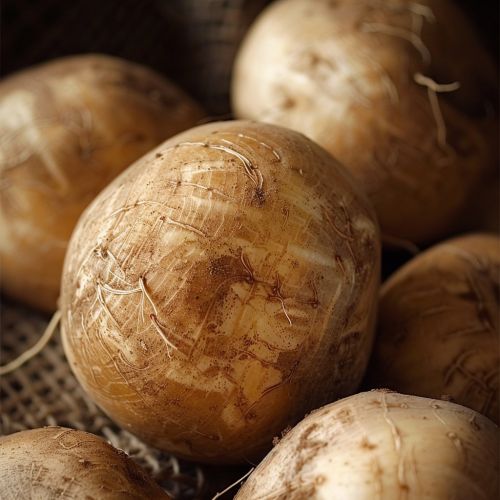Tuber
Introduction
A tuber is a type of modified, subterranean stem of a plant that is enlarged to store nutrients. It is used by plants to survive the winter or dry months and provide energy and nutrients for regrowth during the next growing season. Tubers are also a means of asexual reproduction, as each tuber can give rise to a new plant. Some well-known plants that have tubers include the potato, the Jerusalem artichoke, the sweet potato, the yam, and the dahlia.
Structure and Function
Tubers are characterized by their fleshy, rounded or elongated shape. They are typically covered by a protective skin that can range in color from white to brown to red. The interior of a tuber is filled with starch, proteins, and other nutrients. Tubers are unique among plant structures in that they have the ability to store large amounts of nutrients. This makes them an important food source for animals and humans alike.
Tubers are formed from enlarged stolons, a type of stem that grows horizontally along the ground. The stolon will swell at certain points, forming the tuber. This swelling is caused by the accumulation of nutrients, which are transported to the tuber from the rest of the plant. The tuber also contains buds, known as "eyes", which can sprout and form a new plant.


Types of Tubers
There are two main types of tubers: stem tubers and root tubers.
Stem Tubers
Stem tubers form from thickened rhizomes (underground stems) or stolons. The top sides of the tuber contain the stem's nodes, from which new stems and leaves can sprout. The most famous example of a stem tuber is the potato. Other examples include the Jerusalem artichoke, the yam, and the dahlia.
Root Tubers
Root tubers, on the other hand, are enlarged lateral roots, filled with nutrients. They tend to form in clusters. The sweet potato is the most well-known example of a root tuber. Other examples include the cassava and the dahlia.
Agricultural Importance
Tubers are of great agricultural importance due to their nutrient storage capabilities. They are a staple food in many cultures around the world. The potato, for example, is one of the most widely grown and consumed foods globally. Other tuber crops, like the sweet potato, the yam, and the cassava, are also important food sources, particularly in developing countries.
Tubers are typically harvested by digging up the entire plant. The tubers are then separated from the rest of the plant and stored until they are ready to be used. Tubers can be prepared in a variety of ways, including boiling, baking, and frying.
Ecological Significance
Tubers play a significant role in plant survival and reproduction. They allow plants to survive in harsh conditions, such as during winter or dry seasons, by storing water and nutrients. Tubers also enable plants to reproduce asexually. When a piece of a tuber containing an eye is planted, it can grow into a new plant. This allows for the rapid spread of the plant species.
In addition, tubers serve as a food source for a variety of wildlife. Animals such as voles, squirrels, and deer often dig up and eat tubers, particularly in the winter when other food sources are scarce.
